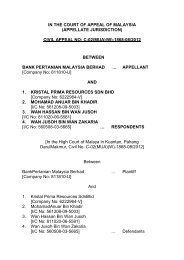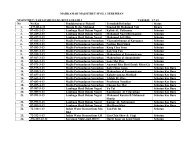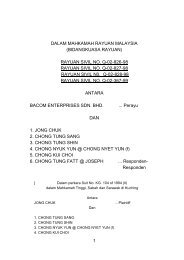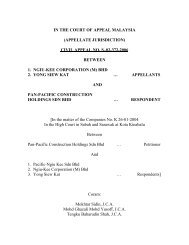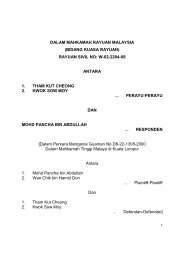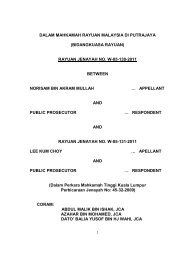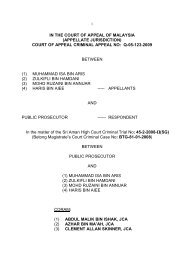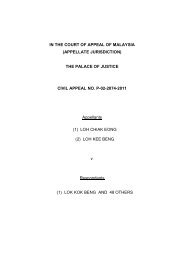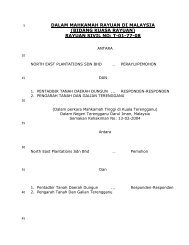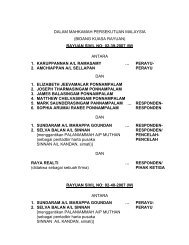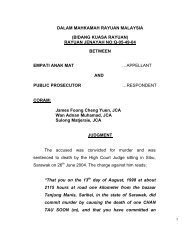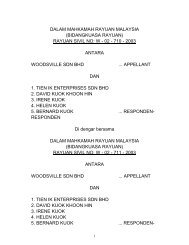rayuan sivil no. j – 02– 641 – 2006 antara ng see liang
rayuan sivil no. j – 02– 641 – 2006 antara ng see liang
rayuan sivil no. j – 02– 641 – 2006 antara ng see liang
Create successful ePaper yourself
Turn your PDF publications into a flip-book with our unique Google optimized e-Paper software.
DALAM MAHKAMAH RAYUAN MALAYSIA<br />
(BIDANGKUASA RAYUAN)<br />
RAYUAN SIVIL NO. J <stro<strong>ng</strong>>–</stro<strong>ng</strong>> 02<stro<strong>ng</strong>>–</stro<strong>ng</strong>> <stro<strong>ng</strong>>641</stro<strong>ng</strong>> <stro<strong>ng</strong>>–</stro<strong>ng</strong>> <stro<strong>ng</strong>>2006</stro<strong>ng</strong>><br />
ANTARA<br />
NG SEE LIANG<br />
DAN<br />
… PERAYU<br />
NG SAY HOON @ NG SAY HUEN … RESPONDEN<br />
(Dalam Mahkamah Ti<strong>ng</strong>gi Malaya di Johor Bahru<br />
Guaman Sivil No: 22-24 Tahun 1998<br />
Antara<br />
Ng See Lia<strong>ng</strong><br />
No. 774, Medan Ko-op<br />
Jalan Bakek<br />
8200 Pontian<br />
Johor … Plaintif<br />
Dan<br />
Ng Say Hoon @ Ng Say Huen<br />
No. 761, Medan Ko-op<br />
Jalan Bakek<br />
8200 Pontian<br />
Johor … Defendan)<br />
Coram: Gopal Sri Ram, J.C.A.<br />
Ahmad bin Haji Maarop, J.C.A.<br />
Ka<strong>ng</strong> Hwee Gee, J.<br />
ORAL JUDGMENT<br />
Gopal Sri Ram, J.C.A. deliveri<strong>ng</strong> judgment:<br />
1. This is the judgment of the Court.<br />
2. The appellant (plaintiff in the court below) and the defendant in<br />
the action (<stro<strong>ng</strong>>no</stro<strong>ng</strong>>w deceased and whose estate is under the<br />
representation as respondent before us) were brothers. The dispute
2<br />
between them concerns 4 lots of land <stro<strong>ng</strong>>–</stro<strong>ng</strong>> we will refer to them as “the<br />
subject land” <stro<strong>ng</strong>>–</stro<strong>ng</strong>> which the appellant says belo<strong>ng</strong>s to him because it<br />
was held in trust for him by the deceased defendant. The<br />
defendant’s case in the court below and before us is that he is the<br />
absolute owner of the subject land. It is <stro<strong>ng</strong>>no</stro<strong>ng</strong>>t in dispute that in 1948<br />
when the deceased defendant was 10 year’s old his father purchased<br />
the subject land and had it registered in the defendant’s name. It<br />
appears that under the Johore Land Enactment then in force in that<br />
State, infancy was <stro<strong>ng</strong>>no</stro<strong>ng</strong>>t a disability in so far as the ownership of land is<br />
concerned. The father died in 1958. In or about 1992, the<br />
defendant decided to develop the land. He entered into an<br />
arra<strong>ng</strong>ement with PW2, a licensed housi<strong>ng</strong> developer to subdivide<br />
the subject land and to construct houses on it. Some of the<br />
subdivided lots were later transferred by the defendant to his other<br />
brothers and sisters. The appellant got <stro<strong>ng</strong>>no</stro<strong>ng</strong>>thi<strong>ng</strong>.<br />
3. The issue before the High Court was whether the land originally<br />
purchased by the father in the defendant’s name was meant as a gift<br />
to him or was intended by him to be held in trust by the defendant for<br />
his sibli<strong>ng</strong>s. The defendant relied heavily in the court below on the<br />
presumption of advancement. Learned counsel for the respondent<br />
has reiterated this argument before us this morni<strong>ng</strong>. And in support<br />
of his response to this appeal he relies on the speech of Viscount<br />
Simonds in the case of Shephard & A<stro<strong>ng</strong>>no</stro<strong>ng</strong>>ther v Cartwright & Others<br />
[1955] AC 431. Here is the passage read to us:<br />
“I think that the law is clear that on the one hand<br />
where a man purchases shares and they are
3<br />
registered in the name of a stra<strong>ng</strong>er there is a<br />
resulti<strong>ng</strong> trust in favor of the purchaser; on the<br />
other hand, if they are registered in the name of a<br />
child or one to whom the purchaser then stood in<br />
loco parentis, there is <stro<strong>ng</strong>>no</stro<strong>ng</strong>> such resulti<strong>ng</strong> trust but a<br />
presumption of advancement. Equally it is clear<br />
that the presumption may be rebutted but should<br />
<stro<strong>ng</strong>>no</stro<strong>ng</strong>>t, as Lord Eldon said, give way to slight<br />
circumstances: Finch v Finch [1808] 15 Ves 43.”<br />
4. While we agree with the view expressed above, we would<br />
hasten to add two qualifications to it. First, it is <stro<strong>ng</strong>>no</stro<strong>ng</strong>>w clear that the<br />
presumption of advancement “is a relatively weak presumption which<br />
can be rebutted on comparatively slight evidence”, to borrow the<br />
words of Neuberger LJ in Laskar v Laskar [2008] EWCA Civ 347,<br />
citi<strong>ng</strong> Lord Upjohn’s speech in Pettit v Pettit [1970] 1 AC 777, at<br />
814. Second, the approach to the ascertainment of a donative<br />
intention must be in accordance with the facts and circumstances of<br />
each case. In our judgment the primary function of the court in a<br />
dispute of this sort is to determine whether the initial do<stro<strong>ng</strong>>no</stro<strong>ng</strong>>r intended<br />
to make a gift of the property be it movable or immovable, or whether<br />
he intended it to be held by the donee in trust for some other person<br />
or persons.<br />
5. In Ha<strong>ng</strong> Geck Kiau v Goh Koon Suan [2007] 6 CLJ 626, this<br />
Court, when deali<strong>ng</strong> with similar case as the present, had this to say:<br />
“In our judgment the correct approach in cases<br />
such as the present is for a court first to determine
4<br />
the true intention of the purchaser. The question<br />
whether the purchaser in a particular case had a<br />
donative intention is to be determined objectively<br />
through a meticulous examination of the facts and<br />
evidence of the surroundi<strong>ng</strong> circumstances. If<br />
after such an examination the court concludes that<br />
there was a donative intention on the part of the<br />
purchaser that is the end of the matter and there is<br />
<stro<strong>ng</strong>>no</stro<strong>ng</strong>> room for the operation of the presumption of<br />
resulti<strong>ng</strong> trust or advancement as the case maybe.<br />
It is only where there are <stro<strong>ng</strong>>no</stro<strong>ng</strong>> or insufficient facts or<br />
evidence from which a fair inference of intention<br />
maybe drawn that a court should turn to<br />
presumptions as a last resort to resolve the<br />
dispute. As Devlin L.J observed in Berry v. British<br />
Transport Commission [1961] 3 All ER 65, 75:<br />
‘... presumptions of law ought to be used<br />
only where their use is strictly necessary<br />
for the ends of justice. They are<br />
inherently undesirable ... because they<br />
prevent the court from ascertaini<strong>ng</strong> the<br />
truth, which should be the prime object of<br />
a judicial investigation, and because, if<br />
they are allowed to multiply to excess, the<br />
law will become divorced from reality and<br />
will live amo<strong>ng</strong> fantasies of it is own.’
5<br />
That the presumption of resulti<strong>ng</strong> trust operates<br />
only where there is absent evidence as to the true<br />
intention of the parties is borne out by what Lord<br />
Upjohn said in Pettitt v. Pettitt [1970] AC 777,814:<br />
‘…in the absence of evidence to the<br />
contrary if the property be conveyed into<br />
the name of a stra<strong>ng</strong>er he will hold it as<br />
trustee for the person putti<strong>ng</strong> up the<br />
purchase money.’ (Emphasis added).<br />
The position is <stro<strong>ng</strong>>no</stro<strong>ng</strong>> different in our jurisdiction as<br />
demonstrated by the followi<strong>ng</strong> passage by SK Das’<br />
work ‘The Torrens System in Malaya’ where the<br />
learned author says this(at p.192):<br />
‘A resulti<strong>ng</strong> trust arises when a person<br />
purchases property in the name of<br />
a<stro<strong>ng</strong>>no</stro<strong>ng</strong>>ther <stro<strong>ng</strong>>no</stro<strong>ng</strong>>t intended as a gift’<br />
(Emphasis added).<br />
We therefore approve of the followi<strong>ng</strong> statement of<br />
the law by Gabriel Moss Q.C (sitti<strong>ng</strong> as a Deputy<br />
High Court Judge) in Kyriakides v Pippas [2004]<br />
EWHC 646 (Ch):<br />
‘Where there is <stro<strong>ng</strong>>no</stro<strong>ng</strong>> declaration, the court<br />
puts itself in the position of a jury and<br />
considers all the circumstances of the<br />
case, so as to arrive at the purchaser’s
6<br />
real intention: Snell para 9-15. It is only<br />
where there is <stro<strong>ng</strong>>no</stro<strong>ng</strong>> evidence to contradict<br />
the presumption that it will prevail: Ibid.<br />
The case-law has developed in such a<br />
way that even “comparatively slight<br />
evidence” will rebut the presumption and<br />
a less rigid approach should also be<br />
adopted to the admissibility of evidence<br />
to rebut the presumption of advancement’<br />
Lavelle v. Lavelle [2004] EWCA Civ 223<br />
(CA) per Lord Phillips MR at para 17.<br />
I suspect the position we have <stro<strong>ng</strong>>no</stro<strong>ng</strong>>w<br />
reached is that the courts will always<br />
strive to work out the real intention of the<br />
purchaser and will only give effect to the<br />
presumptions of resulti<strong>ng</strong> trust and<br />
advancement where the intention can<stro<strong>ng</strong>>no</stro<strong>ng</strong>>t<br />
be fathomed and a ‘lo<strong>ng</strong>-stop’ or “default”<br />
solution is needed.’” (Emphasis added).<br />
6. We would adopt the same approach in the present case. Now,<br />
there is evidence, unrebutted by the defendant, that he instructed<br />
PW2, the developer, to prepare a plan showi<strong>ng</strong> the lots to be given to<br />
his sibli<strong>ng</strong>s includi<strong>ng</strong> the appellant. This is very stro<strong>ng</strong> evidence that<br />
the defendant treated his conscience as bei<strong>ng</strong> bound by a trust.<br />
Additionally, the defendant’s answer to the appellant’s case in the<br />
court below appeared in wholly inconsistent versions. In his pleaded
7<br />
case he said that he did <stro<strong>ng</strong>>no</stro<strong>ng</strong>>t transfer the 4 lots in question to the<br />
appellant because he had already settled other property upon him.<br />
In his evidence in chief, given in the form of a witness statement he<br />
said he kept the appellant out because they were <stro<strong>ng</strong>>no</stro<strong>ng</strong>>t in good terms.<br />
In an affidavit affirmed on 17 September 1998 he said that he was <stro<strong>ng</strong>>no</stro<strong>ng</strong>>t<br />
under an obligation to settle the 4 lots on the appellant because the<br />
latter was established in business and was financially well off.<br />
Although there is <stro<strong>ng</strong>>no</stro<strong>ng</strong>> written judgment from the learned judge who<br />
passed away before he could write it, it is apparent to us that he<br />
could <stro<strong>ng</strong>>no</stro<strong>ng</strong>>t possibly have addressed his mind to this inconsistency.<br />
Here you have a case where a you<strong>ng</strong> child is given the property<br />
which he some 40 years later asserts as his own as havi<strong>ng</strong> been<br />
gifted to him. The man who made the gift was dead when the<br />
assertion was made. Based on his own evidence of ill will against<br />
the appellant, there was a stro<strong>ng</strong> motive for the defendant to deny the<br />
trust. This is an element which the learned judge should have taken<br />
into consideration when assessi<strong>ng</strong> the defendant’s evidence. It is<br />
our respectful view that had the learned judge judicially appreciated<br />
the defendant’s evidence and treated it with suspicion and caution he<br />
would <stro<strong>ng</strong>>no</stro<strong>ng</strong>>t have found against the appellant. Put differently, a<br />
reasonable tribunal acti<strong>ng</strong> upon the facts and evidence presented to<br />
the court below in the instant case and properly directi<strong>ng</strong> itself on the<br />
law would have found against the defendant.<br />
7. Havi<strong>ng</strong> come to the conclusion there could have been <stro<strong>ng</strong>>no</stro<strong>ng</strong>><br />
judicial appreciation of the evidence we have <stro<strong>ng</strong>>no</stro<strong>ng</strong>> alternative but to<br />
intervene. True it is that the ri<strong>ng</strong> of truth is more audible to the
8<br />
primarily trier of fact. See Ryan v Jarvis [2005] UKPC 27. But<br />
where, as here, there has been a failure to properly evaluate the<br />
proved and admitted facts, it is the function, and indeed the duty of<br />
this court, to intervene and put matters right.<br />
8. For the reasons already given, the appeal is allowed. There<br />
shall be judgment for the appellant in the followi<strong>ng</strong> terms:<br />
(a) a declaration that the defendant holds the 4 Lots<br />
described as HS (D) 5644 PTD 10702, HS (D) 5630<br />
PTD 10688, HS (D 5685 PTD 10743 and HS (D)<br />
5686 PTD 10744 all in the Mukim of Pontian<br />
together with the dwelli<strong>ng</strong> house and shophouse<br />
erected thereon as a trustee of the plaintiff, Ng See<br />
Lia<strong>ng</strong>;<br />
(b) a declaration that the plaintiff Ng See Lia<strong>ng</strong> is the<br />
beneficial owner of all that 4 Lots described as HS<br />
(D) 5644 PTD 10702, HS (D) 5630 PTD 10688, HS<br />
(D) 5685 PTD 10743 and HS (D) 5686 PTD 10744.<br />
(d) an order that the defendant do convey and transfer<br />
the property k<stro<strong>ng</strong>>no</stro<strong>ng</strong>>wn as HS (D) 5644 PTD 10702,<br />
HS (D) 5630 PTD 10688 HS (D) 5685 PTD 10743<br />
and HS (D) 5686 PTD 10744 into the name of the<br />
plaintiff forthwith;<br />
(e) an order that the defendant do discharge of charge<br />
on Lots held under HS (D) 5685 Lot 10743 and HS
9<br />
(D) 5686 Lot 10744 from Hock Hua Bank Berhad<br />
within 30 days from the date of this order.<br />
9. The appellant will also have his costs here and in the court<br />
below. The deposit in court is to be refunded to the appellant.<br />
Judgment delivered in Open Court at the conclusion of arguments on<br />
2 March 2009.<br />
Counsel for the appellant: Hisyam Teh Poh Teik (Sukhaimi<br />
Mashud with him)<br />
Solicitors for the appellant: Tetuan Teh Poh Teik & Co.<br />
Counsel for the respondent: S. Gunasegaran<br />
Solicitors for the respondent: Tetuan John A<strong>ng</strong> & Jega<br />
Verified with Y.A. Gopal Sri Ram, J.C.A. and certified by me to be<br />
correct.



